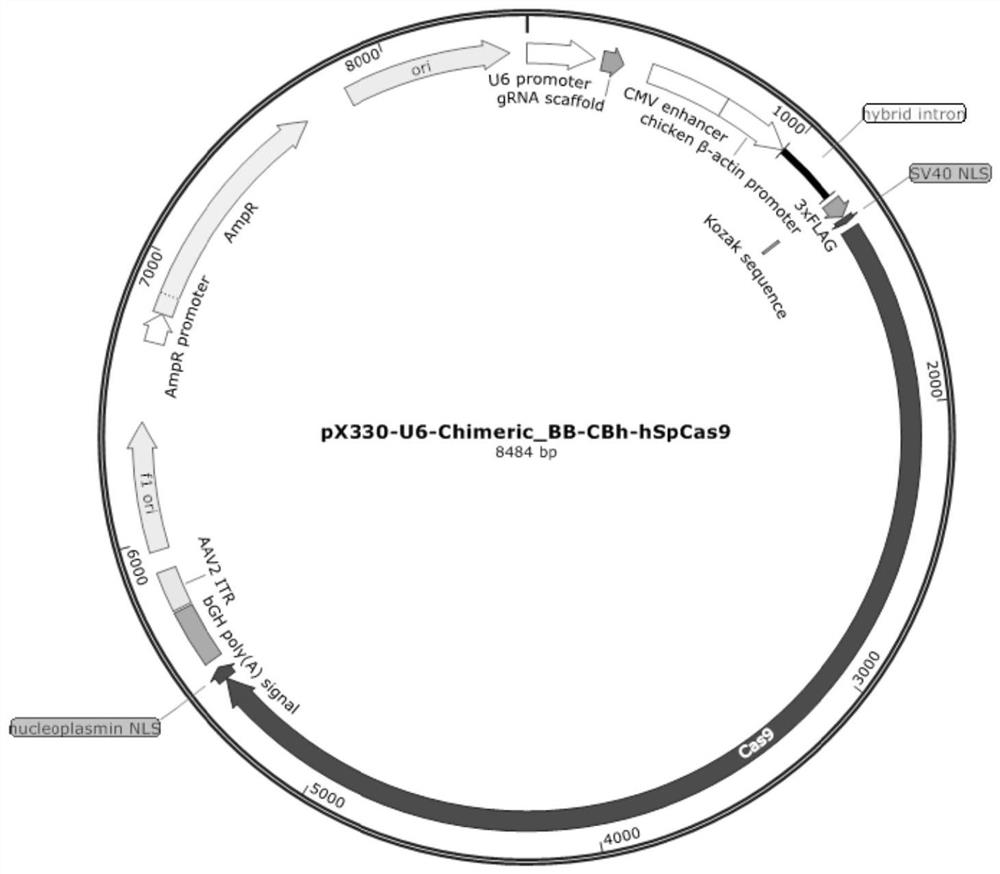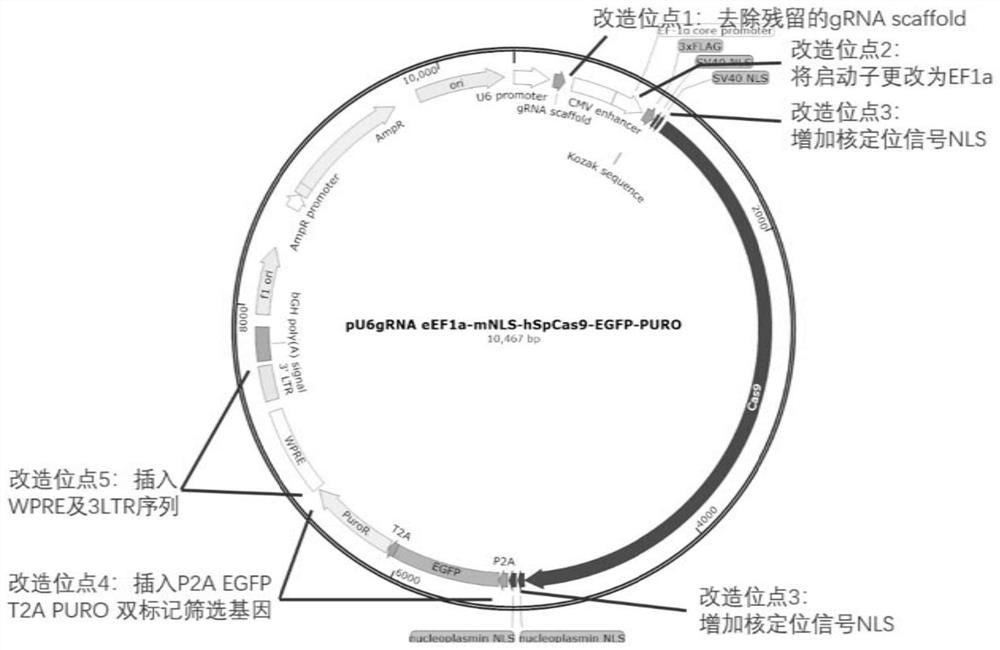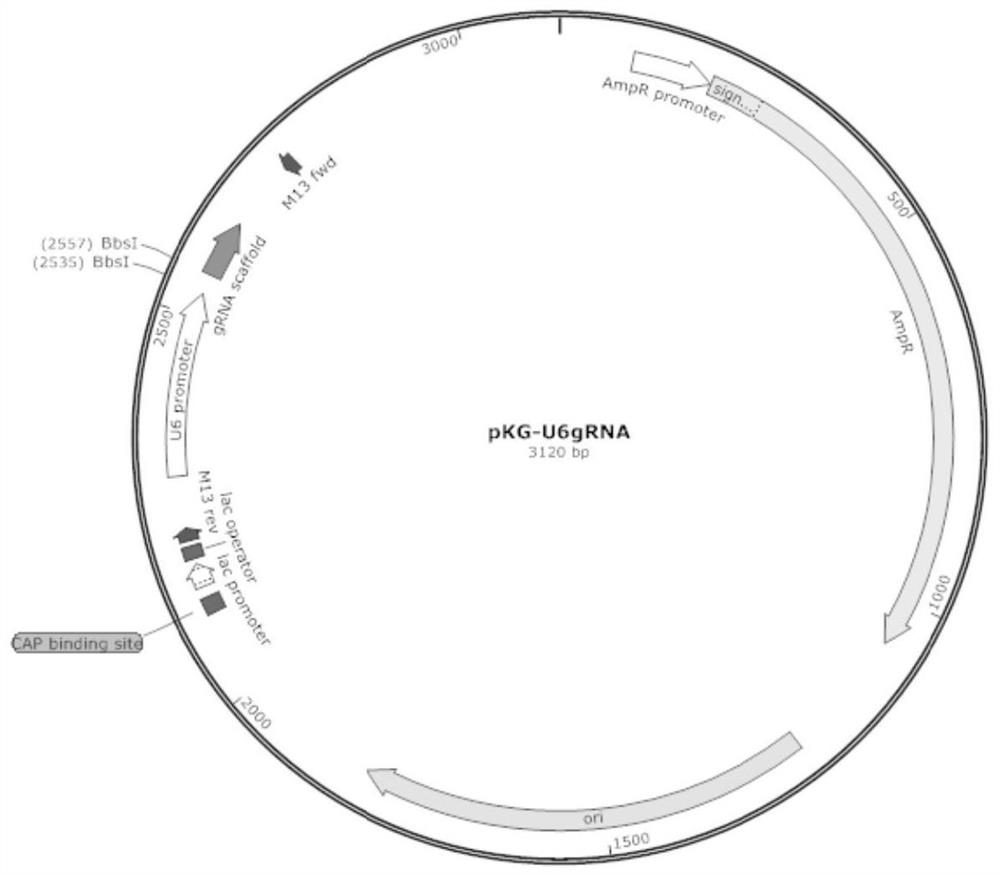Recombinant cell with IL2RG gene and ADA gene knocked out jointly and application of recombinant cell in preparation of immunodeficient swine model
A technology of recombinant cells and immunodeficiency, applied in genetically modified cells, bone/connective tissue cells, cells modified by introducing foreign genetic material, etc., can solve problems such as damage and lymphocyte dysfunction
- Summary
- Abstract
- Description
- Claims
- Application Information
AI Technical Summary
Problems solved by technology
Method used
Image
Examples
Embodiment 3
[0080] 8 pigs in embodiment 3 and embodiment 4 are all just born Congjiang Xiang pigs, wherein 4 females (respectively named 1, 2, 3, 4), male 4 (named respectively A, B, C, D).
[0081]The method for preparing pig primary fibroblasts: ① Take 0.5 g of pig ear tissue, remove the hair, then soak in 75% alcohol for 30-40 seconds, and then wash with PBS buffer containing 5% (volume ratio) Penicillin-Streptomycin (Gibco) 5 times, then washed once with PBS buffer; ②cut the tissue with scissors, digest with 5mL 1% collagenase solution (Sigma) at 37℃ for 1h, then centrifuge at 500g for 5min, discard the supernatant; Resuspend the culture medium, and spread it into a cell culture dish with a diameter of 9 cm containing 10 mL of complete medium and sealed with 0.2% gelatin (VWR), and culture until the cells cover about 60% of the bottom of the dish; ④After completing step ③ , use trypsin to digest and collect the cells, and use the cell freezing medium (90% complete medium + 10% DMSO, ...
Embodiment 1
[0083] Embodiment 1, the preparation of plasmid
[0084] The plasmid pX330-U6-Chimeric_BB-CBh-hSpCas9 was prepared, as shown in SEQ ID NO:1. Plasmid pX330-U6-Chimeric_BB-CBh-hSpCas9, referred to as plasmid pX330.
[0085] The plasmid pU6gRNA eEF1a-mNLS-hSpCas9-EGFP-PURO was prepared, as shown in SEQ ID NO:2. Plasmid pU6gRNA eEF1a-mNLS-hSpCas9-EGFP-PURO, referred to as plasmid pKG-GE3.
[0086] The plasmid pKG-U6gRNA was prepared, as shown in SEQ ID NO:3.
[0087] Plasmid pX330, plasmid pKG-GE3, and plasmid pKG-U6gRNA are all circular plasmids.
[0088] The schematic diagram of the structure of plasmid pX330 is shown in figure 1 . In SEQ ID NO: 1, the 440-725 nucleotides form the CMV enhancer, the 727-1208 nucleotides form the chickenβ-actin promoter, and the 1304-1324 nucleotides encode the SV40 nuclear localization signal (NLS ), the 1325-5449th nucleotide encodes the Cas9 protein, and the 5450-5497th nucleotide encodes the nucleoplasmin nuclear localization signal (NLS...
Embodiment 2
[0092] Embodiment 2, the effect comparison of plasmid pX330 and plasmid pKG-GE3
[0093] Select two gRNA targets located at the MSTN gene:
[0094] Target of MSTN-gRNA1: 5'-GCTGATTGTTGCTGGTCCCG-3';
[0095] Target of MSTN-gRNA2: 5'-TTTCCAGGCGAAGTTTACTG-3'.
[0096] Select two gRNA targets located at the FNDC5 gene:
[0097] Target of FNDC5-gRNA1: 5'-TGTACTCAGTGTCCTCCTCC-3';
[0098] Target of FNDC5-gRNA2: 5'-GCTCTTCAAGACGCCTCGCG-3'.
[0099] Primers used to amplify target-containing fragments are:
[0100] MSTN-F896: 5'-TCTCTCAGACAGTGCAGGCATTA-3';
[0101] MSTN-R1351: 5'-CGTTTCCGTCGTAGCGTGATAAT-3'.
[0102] FNDC5-F209: 5'-CAGTTCTCACTTGATGGCCTTGG-3';
[0103] FNDC5-R718: 5'-AGGGGTCTGGGGAGGAATGG-3'.
[0104] 1. Preparation of recombinant plasmids
[0105] The plasmid pKG-U6gRNA was taken, digested with restriction endonuclease BbsI, and the vector backbone (a large linear fragment of about 3 kb) was recovered.
[0106] MSTN-1S and MSTN-1A were synthesized separately, t...
PUM
 Login to View More
Login to View More Abstract
Description
Claims
Application Information
 Login to View More
Login to View More - R&D
- Intellectual Property
- Life Sciences
- Materials
- Tech Scout
- Unparalleled Data Quality
- Higher Quality Content
- 60% Fewer Hallucinations
Browse by: Latest US Patents, China's latest patents, Technical Efficacy Thesaurus, Application Domain, Technology Topic, Popular Technical Reports.
© 2025 PatSnap. All rights reserved.Legal|Privacy policy|Modern Slavery Act Transparency Statement|Sitemap|About US| Contact US: help@patsnap.com



